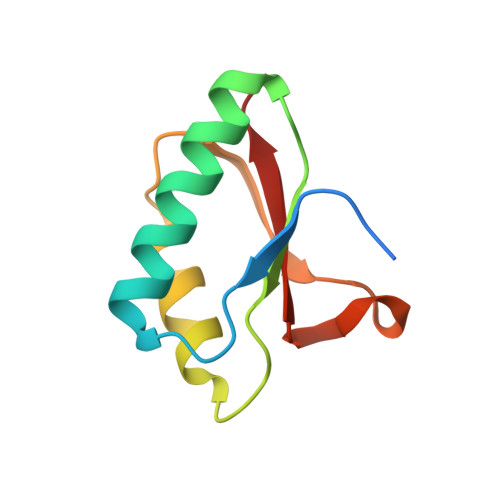Structural and functional studies of MutS2 from Deinococcus radiodurans.
Zhang, H., Xu, Q., Lu, M., Xu, X., Wang, Y., Wang, L., Zhao, Y., Hua, Y.(2014) DNA Repair (Amst) 21: 111-119
- PubMed: 24811920
- DOI: https://doi.org/10.1016/j.dnarep.2014.04.012
- Primary Citation of Related Structures:
4OCH, 4OD6 - PubMed Abstract:
The MutS2 homologues have been found widespread in most prokaryotes, which are involved in DNA repair and reactive oxygen species detoxification. The C-terminal small mutS-related (Smr) domain is critical for its endonucleolytic activity. However, the detailed catalytic mechanism is still unclear. In this study, we first investigated the in vivo role of drMutS2 in Deinococcus radiodurans, the most radiation-resistant organism exhibits the remarkable DNA repair capacity. mutS2 and recA mutS2 double knockout mutants were constructed because the phenotype was strongly masked by the predominant homologous recombination DNA repair pathway in this bacterium. Compared with the recA mutant, cells devoid of both genes showed increased sensitivity to ionizing radiation and oxidative agents, suggesting that drMutS2 is involved in RecA-independent mechanisms that enhance cellular resistance to oxidative stress-induced DNA damage. Moreover, the basal level of reductase activity and thiamine biosynthesis was induced in the absence of mutS2. To characterize its catalytic residues, the Smr domain was crystallized and soaked in buffer containing manganese ions. In contrast to native crystals, the space group of manganese-derivative crystals transformed from monoclinic to orthorhombic unexpectedly. This type of crystals showed improved diffraction resolution to 1.2 Å, which has the highest resolution of currently known Smr structures. Structural comparison revealed that three acidic amino-acid residues, which are all located in the α1 helix, changed the rotamer states after metal soaking. Mutational analysis of conserved residue glutamic acid 710 to alanine yielded a drMutS2 variant with impaired nuclease activity, and could only partially rescue the radiosensitive phenotype of the mutS2 null strain, indicating that glutamic acid 710 is the catalytic residue.
Organizational Affiliation:
Key Laboratory of Chinese Ministry of Agriculture for Nuclear-Agricultural Sciences, Institute of Nuclear-Agricultural Sciences, Zhejiang University, China.














